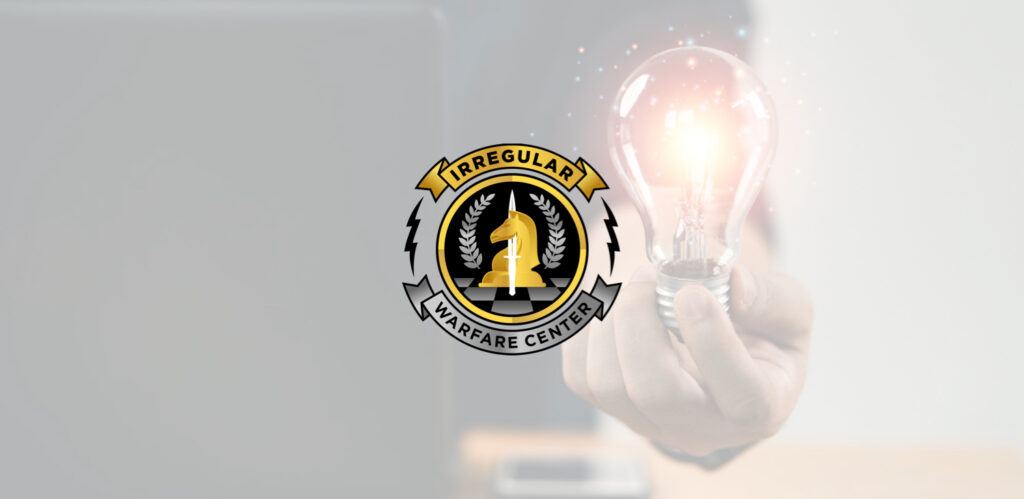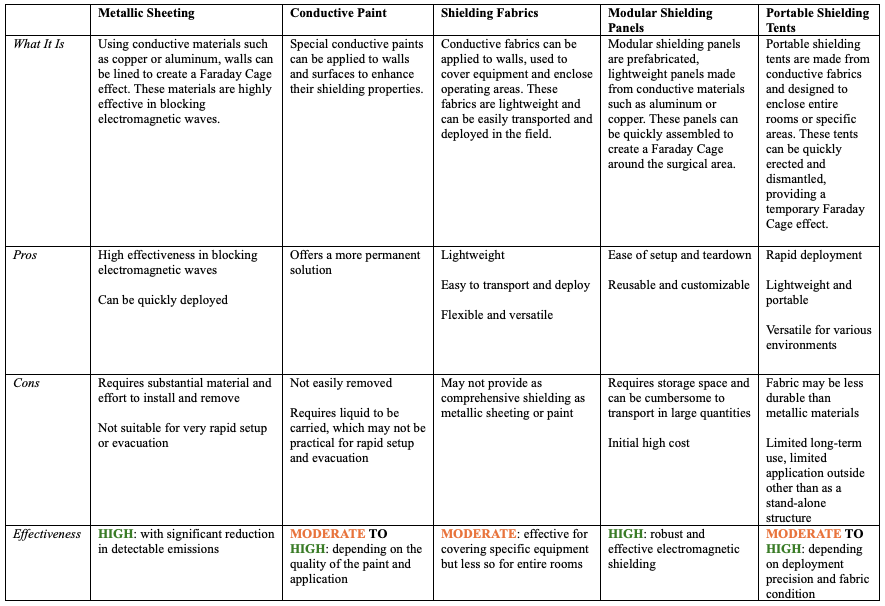
Stealth Surgery: Mitigating Signature Detection Risks for Special Operations Surgical Teams
Dr. Aaron Epstein – IWC Medical Subject Matter Expert (Contractor, Valens Global)
Laura Wolff – Medical Assistant, DO Candidate
In modern warfare, United States (U.S.) military special operations frequently employ unconventional and irregular tactics, often operating in environments denied by opposition forces. Special Operations surgical teams (SOST) provide immediate medical care in these high-risk environments, with their success and safety heavily dependent on avoiding detection of any kind. However, the electronic medical equipment used, such as patient monitors and ventilators, emit electromagnetic radiation that adversaries can detect with sensors and analysis systems. As nations like Russia and China continue to enhance their electronic warfare (EW) capabilities, the need for robust countermeasures becomes increasingly critical.
As such, SOSTs need to consider options for electromagnetic shielding, utilizing practical solutions to mitigate the risks of detection. By understanding the threat landscape and specific vulnerabilities, SOSTs can develop and implement effective shielding techniques that not only enhance team survivability but also contribute to the overall success of special operations missions.
The Threat Landscape
Adversaries like Russia and China have heavily invested for decades in advancing EW capabilities, enabling them to detect and target electromagnetic emissions from electronic devices routinely used by U.S. military forces. Reportedly, this has also extended to targeting electromagnetic emissions specifically from military medical teams. This is made even easier due to military medical equipment being easily acquired commercially whereas most other military hardware is heavily restricted in terms of acquisition and possession. Adversaries can easily acquire this equipment and analyze their electromagnetic signatures, and develop specialized detection tools, known as “sniffers.” These sniffers can then be deployed on drones or other remote sensors to identify the presence of SOSTs, compromising their operational security and potentially leading to devastating attacks.
In Ukraine, for example, instances of forward surgical teams being targeted by Russian forces have been unprecedented in modern warfare, though the exact methods used by Russia to target them is understandably open to question. A surgical team operating with due regard in terms of managing thermal emissions and communications equipment was attacked by Russian rockets after a Russian drone had been noted in the area. It was speculated that the significant amount of medical equipment and monitors may have given off enough emissions to be detected by the Russian drone if the drone had been tuned to the emissions of the medical devices.
Challenges of Electromagnetic Emissions
All electronic devices emit some level of electromagnetic radiation, making it challenging to maintain a low profile during sensitive operations. The United States and its allies have exploited electromagnetic emissions for intelligence purposes for decades. Adversaries can easily obtain and analyze commercially available medical devices to identify their unique signatures. Once these signature patterns are established, enemies can tune their electromagnetic detection equipment to locate SOSTs with precision.
The challenge of preventing detection by adversary forces of electromagnetic emissions is compounded by the extensive variety of devices used in medical care. Multiple medical devices in a room are practically easier to shield and contain than to counter several specific frequencies being emitted and detected. Additionally, shielding offers a passive way to contain emissions whereas the activity of a jamming device itself gives away the position of a sensitive U.S. team or asset—when trying to be stealthy, it does not help to blast electromagnetic signals at the opposition detection device. With each device emitting a distinct signature, shielding, where electromagnetic signals are contained within an enclosed space, proves to be more practical than jamming (finding an opposition sensor device and then targeting and overloading that device with essentially static). It is no surprise that for decades, the U.S. has used the concept of shielding or containing all emissions within a site as a way to prevent detection by adversaries and has standards set for the construction of sensitive government installations. However, these standards have not been applied to forward deploying U.S. surgical teams.
Implementing Effective Electromagnetic Shielding
The most practical approach to shielding involves rapidly applying conductive metallic sheeting to the walls of the operating room or medical safehouse, creating a Faraday Cage effect. A Faraday cage can contain electronic emissions from a device inside it by preventing electromagnetic waves from escaping. The metal structure of the cage conducts the waves and redistributes them, effectively blocking them from passing through to the outside. This keeps the emissions contained within the cage, making it useful for testing electronic devices or ensuring that sensitive information doesn’t leak from electronic equipment.
In a low resourced or austere setting, a Faraday cage effect can be created by applying metallic sheeting made from copper or aluminum to the walls of the operating area. These metals are effective in blocking electromagnetic waves and creating a contained environment. Utilizing metallic sheeting, SOSTs can significantly reduce their electromagnetic signature, making it more difficult for adversaries to detect their presence.
In addition to metallic sheeting, other practical and commercially available methods for achieving the Faraday Cage effect include the use of conductive paints—which mix electrically conductive materials into a paint—and shielding fabrics, which can block electromagnetic energy from being transferred. In a similar fashion to metallic sheeting, conductive paints can be applied to walls and surfaces to enhance their shielding properties while shielding fabrics can be used to cover equipment and enclose operating areas. These methods can be implemented easily and be tailored to the specific needs of SOSTs based on operational and mission demands.
Modular shielding panels are yet another option for commercial and relatively low-cost electromagnetic shielding. Modular shielding panels are prefabricated, lightweight panels made from conductive materials such as aluminum or copper. These panels can be quickly assembled to create a Faraday Cage around the surgical area.
Lastly, SOSTs can consider creating prefabricated surgical tents that have built in electromagnetic shielding properties. The advantage of prefabricated shielding tents is that they are ready to go and do not require application of materials to the walls since they are inherent in the tent structure itself. The limitation with these tents is that they could not be applied in settings like safehouses or deployed within existing structures with limited space whereas tacking a shielding fabric to the walls would be practical in confined or unusual shaped operating spaces.
Materials and Methods for Electromagnetic Shielding

Prioritizing Signature Management
Physically shielding devices and areas that emit electromagnetic signals is one step. But there are other measures SOSTs can take to minimize their electronic signatures: improve training in electronic warfare methods; procure medical equipment with lower electromagnetic emissions; and create effective overall operating procedures for signature management. These measures should not only be the purview of electronic warfare or measurement and signature intelligence subject matter experts.
Firstly, training in and awareness of EW are essential. It is imperative that all personnel be cognizant of the risks associated with electromagnetic emissions and understand the critical importance of maintaining a low physical and electric profile during sensitive operations. Training programs dedicated to EW should educate service members on the concepts and consequences of EW, and on the various methods and techniques for reducing electromagnetic emissions. These training programs should emphasize the significance and impact of EW on operational security and equip personnel with the knowledge and skills needed to effectively manage and mitigate the risks associated with electromagnetic signatures and EW tactics.
Secondly, modifying and procuring medical equipment with reduced electromagnetic emissions is vital. This approach involves working closely with manufacturers to design and produce medical devices that are specifically tailored for use in high-risk, sensitive environments. The goal is to develop equipment that inherently emits lower levels of electromagnetic radiation. By integrating low-emission devices into their operations, SOSTs can significantly reduce their electromagnetic footprint, thereby minimizing the risk of detection. Although this process requires an initial investment in terms of cost and time for development and procurement, the long-term benefits to operational security would be substantial.
Lastly, the implementation of standard operating procedures (SOPs) is critical to managing electromagnetic signatures effectively. These procedures should be designed to simultaneously minimize the use of electronic devices in high-risk environments and promote the adoption of shielding techniques. EW-specific SOPs would provide clear guidelines and best practices that can be integrated into existing protocols, ensuring that all team members adhere to measures that reduce electromagnetic emissions. By consistently applying, modifying, and improving these SOPs, SOSTs can maintain a lower electromagnetic profile and improve their ability to operate covertly in hostile environments.
At the macro level, beyond SOST-specific actions, there are many steps the U.S. military can take to improve its signature management. The U.S. military could invest in research and development to identify the most effective materials and methods for creating effective electronic emission shielding in forward conditions which goes beyond the well-established studies and practices on fixed installations or small Faraday pouches of individual electronics of clandestine and unconventional units. Ideally, electromagnetic shielding materials will become as ubiquitous for U.S. military forces as camouflage netting. This includes testing various metallic sheeting, conductive paints, shielding fabrics, modular shielding panels, and portable shielding tents in various conditions to determine their respective effectiveness in different operational environments. Such tests will provide a comprehensive understanding of best practices to functionally enhance operational security.
The U.S. military could also establish a comprehensive signature management program that encompasses all special operations teams. This program should include training, equipment modifications, and the development of complimentary SOPs to ensure that electromagnetic emissions are minimized and effectively contained.
Conclusion
The detection threat posed by the advanced electronic warfare capabilities of near-peer adversaries like Russia and China necessitates the implementation of electromagnetic shielding for U.S. military special operations surgical teams. By adopting effective shielding solutions and prioritizing signature management, the U.S. military can enhance the operational security of these critical medical units, ensuring their ability to operate effectively in hostile environments. Continued investment in research, training, and equipment development is essential to stay ahead of emerging threats and protect the lives of service members in the field.
The views expressed in these articles are those solely of the authors and do not reflect the policy or views of the Irregular Warfare Center, Department of Defense, or the U.S. Government.
